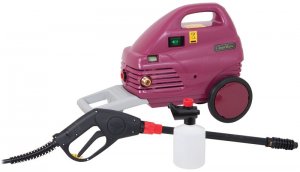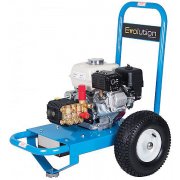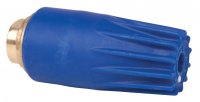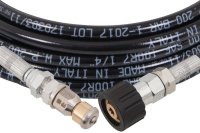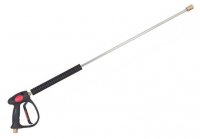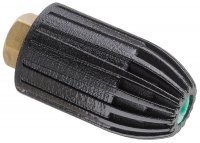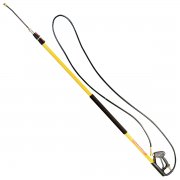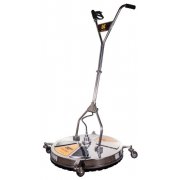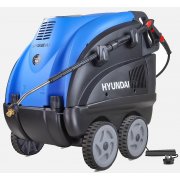This guide is to help you understand what a pressure washer does and what you need to look for when deciding to purchase one. If you’re ready to start shopping, check out the pressure washers at Lawnandpower.co.uk Or keep reading to learn more about the following:
- How does a Pressure Washer Work
- Pressure Washer Pumps
- Direct Drive or Belt Drive
- Water Feeds
- Petrol or Electric
- Pressure Washer Accessories
- Choosing the Right Pressure Washer
How a Pressure Washer Works
A pressure washer is actually a fairly simple piece of equipment. A motor or engine turns a pump, pushing water through an orifice (tip). The water accelerates as it goes through the small hole, much like a river flows faster in a narrow gorge, and that fast-moving water is very useful for blasting dirt and grime. The math is quite simple. Each time the pump turns over, a specific volume of water is pushed through the tip. The more water you push through the tip, the more pressure is developed, and therefore more power is required. The higher the pressure, the faster the water moves, and the harder it hits the dirt, removing it from the surface you want to clean.
What to Consider
The two most important considerations when buying a pressure washer are flow rate, which determines how long it takes to do the job or how many jobs you can do in a day; and life expectancy, which determines how many hours of work you can do per pound spent during the life of the machine.
Understanding Ratings
Here are some basic ratings:
Horse Power (HP) Engine (CC)
This is how much power the engine or motor produces. The larger the HP or engine size CC (cubic capacity or size) the more power the unit can produce. This rating is important because it directly relates to how much pressure and volume (flow rate) the pump can produce.
Pounds Per Square Inch (PSI or Pressure)
The pressure generated by a pressure washer is measured in pounds per square inch or PSI. Pressure contributes to the cleaning force. Do you know what PSI you wanted?
Litres Per Minute (LPM or Flow Rate)
The water volume produced by a pressure washer is measured in litres per minute or LPM (flow rate). The volume also contributes to the cleaning force. Did you know the flow rate you needed?
Often consumers are so focused on the PSI rating of the machine, they do not consider the CPU. For example, a pressure washer may have a rating of 2,800 PSI and 2 GPM, giving it a CPU of 5,600. Another pressure washer is rated for 2,400 PSI and 4 GPM. That’s a CPU rating of 9,600. In this example, the lower PSI machine has more than 40% greater cleaning power than the higher PSI machine. The result is that the 2,400 PSI machine will be able to clean an area 40% faster than the 2,800 PSI machine.
Now consider this: A garden hose typically provides 6 GPM at 10 PSI giving it 60 CPU. With a standard spray nozzle attached to the garden hose, you can get around 5 GPM at about 40 PSI generating 200 CPU. We all have seen the difference of how much more effective a simple spray nozzle is at cleaning dirt off surfaces. Trying to clean your driveway with your garden hose spray nozzle generating 200 CPU is fairly ineffective. However, if we take a mid-range pressure washer rated at 2.0 GPM and 2,500 PSI (5,000 CPU), the CPU rating represents a staggering 25 times increase over a typical garden hose spray nozzle.
A commercial pressure washer rated at 4 GPM and 4,000 PSI is an incredible 16,000 CPU. It is not difficult to see the difference in efficiency. However, this is all true within a range. If you have extremely high pressure and low volume, you can cut steel or concrete (water jet cutter), and if you have extremely high volume and low pressure, you have a river. Neither of these would be very good for cleaning your house or driveway.
Pressure washer pumps have pistons and valves similar to a gas engine or an air compressor. On some pumps, the pistons are driven by a wobble plate. On others, the pistons are driven by a crankshaft. Crankshaft-driven pumps are generally built better and will last longer.
Pressure Washer Pumps
This is the part of the pressure washer that receives water from your hose and pumps it through a tip at high pressure. There are several common types of pumps that you will see in commercial and home-owner-type machines. All pressure washer pumps have pistons and valves similar to a gas engine or an air compressor. On some pumps, the pistons are driven by a plate on an angle (wobble plate), and in other cases, the pistons are driven by a crankshaft. Crankshaft-driven pumps are generally built better and will last longer.
Pressure washer pumps are equipped with bypass valves, so that when you let go of the trigger, or when the tip gets plugged, the water will bypass and go back to the inlet side of the pump. If left in this mode for longer than the manufacturer recommends, the water will get hot and cause damage to the pump. On a petrol-powered pressure washer, the pump includes a thermal relief valve that dumps hot water into the bypass loop. Most bypass valves are adjustable so you can dial down the pressure when cleaning sensitive materials
Low-cost pressure washers have pumps with very low life expectancies—some as low as 60 – 100 hours. When buying a pressure washer, make sure you find out the life expectancy of the pump. If the information is unavailable, stay clear because it is very likely that the manufacturer does not want you to know how low it is.
Another very important factor to consider is parts availability. KMS Tools was a warranty/service centre for some low-end brands, however, the lack of parts availability and unreliability of these machines were such a problem that we decided to no longer provide this service.
Before buying your machine, ask where you can get parts if you need them. KMS is often referred to by other retailers as a source for parts and repairs for numerous brands that are pretty much disposable. If you are buying a new machine for $200.00 or less, expect it to be a disposable machine that might last you only one season, and be prepared to spend a lot of time to get the job done.
Direct Drive or Geared Drive
The drive describes how the motor is connected to the pump. Direct-drive systems are most common. The pump is bolted directly to the motor or engine with a shaft coupler. Compared to a gear-drive system, the direct drive requires fewer parts and space, resulting in a more compact design. Direct drive is also considerably more economical than an equivalently rated geared-drive machine.
Gear-drive systems are typically seen on industrial platforms. The pump on a gear-drive unit turns at a much slower speed. Since the pump turns at a lower speed all the pistons and valves in the pump are larger. All this adds up to a cooler running machine that will last considerably longer than an equivalent direct drive version. However, there is slightly more maintenance and considerably more pounds involved (10 – 30% more). If you are using your pressure washer on the job, then you want to consider buying a gear-drive machine. However, an equivalent direct-drive machine will have the same performance for a lot less money.
Water Feeds
When buying a pressure washer, one thing you may need to consider is how you intend to supply water to the unit. In the UK most domestic units will have a flow rate of under 9 LPM and can be supplied from a tap supply. When looking at higher spec units you may need a buffer tank to run the unit from. These will be needed on higher spec units from over 9/20 LPM flow rate, this could be an IBC or even a wheely bin is often used.
Petrol Engine or Electric Motor
On a pressure washer, the engine or motor powers the pump. The more powerful the engine or motor (rated in HP), the greater the PSI (pressure) and LPM (flow rate) the pump produces. Petrol engines are typically designed to last between 300 and 3,000 hours. The motors on electric pressure washers usually last longer than the pumps.
Electric Motors
Electric motors are very low maintenance and fairly quiet. There is also no exhaust so they can be operated indoors or in poorly ventilated areas. A typical electric pressure washer that is 1230 Volt and 15 Amps will be fairly light duty because it is built for the low-price market. The motor is not strong enough to generate much pressure or volume. While electric pressure washers are compact and usually portable, most jobs take longer with a light-duty electric pressure washer.
HP is rated differently on electric motors compared to petrol engines. A typical low-price electric pressure washer is rated around 1 to 1-1/2 HP and would be equivalent to a 3 HP petrol pressure washer. (Electric motor HP has to be doubled to equal petrol engine HP.)
Heavy-duty electric pressure washers are available for applications where power is available and portability isn’t a factor, and exhaust from a petrol engine would be a problem.
View the range of electric machines HERE
Petrol Engines
Petrol pressure washers are larger and heavier and mounted on a trolley with wheels. Some are better balanced and easier to manoeuvre. Petrol engines can produce more power and are a lot more mobile as they do not need to be plugged into an electric power source. Since petrol engines can be more powerful, the pump can generate considerably more PSI and LPM so that they can clean faster and deeper than any 230 Volt rated electric pressure washer could. However, they do take a little more maintenance and cost more to operate. They must be used in well-ventilated areas because of the emission of carbon-monoxide fumes.
Pressure Washer Accessories
Without accessories, your pressure washer is fairly useless. It would be like having a drill without any drill bits. We offer a great range to suit the units we offer for sale.
Pressure Washer Hoses
Your pressure washer will be supplied with a hose, the length will vary from around 8m upwards depending on what machine you go for. You can also get much longer hoses if needed to suit your unit, if you are unsure what hose you need one of our team will be happy to advise you on what is needed.
Pressure Washer lances and Tips
The lance includes a handle with a trigger valve, and different lengths and angles of lances are available for different applications. You can change the spray pattern by changing the tip at the end of the wand. Most pressure washers come with a selection of tips—from a very narrow spray to generate higher force at the tip for deeper cleaning to a wider spray that has less force but covers more area. Most tip sets also include a low-pressure tip for applying cleaning solutions.
In addition to tips, other, very useful attachments are available:
Turbo Nozzle
A turbo nozzle or rotary nozzle attaches to the end of your wand. It has a very narrow spray that spins in a circular motion very rapidly. Turbo nozzles are effective because they can quickly clean hard surfaces very well and, when used properly, avoids the tiger striping effect on your driveway that happens with conventional spray tips.
Extension/Telescoping Lances
For cleaning out-of-reach areas, look for an extension lance that’s adjustable up to 24 feet in some cases. Extension and telescoping lances are beneficial if you need to reach up high. They can save you from trying to pressure wash while standing on a ladder.
Gutter Cleaners
A gutter cleaner is a simple hooked extension that affixes to the end of your lance or extension. It lets you get into your gutters to clean them out.
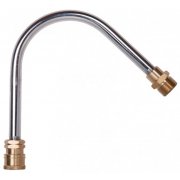
Whirl-A-Ways
A Whirl-A-Way is an accessory that looks a little like a lawn mower and has two or three rotating nozzles inside. They are available in sizes from 12” to 30” and excel at cleaning large flat areas quickly.
Hot Water Pressure Washers
Hot water pressure washers are mainly commercial machines with built-in water heaters. The cleaning effect of the machines is considerably better than a cold water machine with comparable PSI and LPM because hot water simply cleans more effectively than cold water. Hot water pressure washers break down and remove dirt and grime faster than cold water pressure washers, often eliminating the need for expensive chemicals. Do not feed hot water into a normal cold water pressure washer pump. The heat will damage seals and o-rings.
Detergents
Detergents can greatly increase the speed of cleaning and help remove tough stains. Most pressure washers come equipped with a venturi tube that will draw in the detergent from a bottle or pail and add it to the water stream. The detergent should be first applied with a low-pressure spray, given some time to do its work to break down the dirt, and then washed off with a normal high-pressure spray.
Choosing the Right Pressure Washer
When it comes right down to it, you need to buy a pressure washer that fits your application. There are many different types of pressure washers—from very low-end machines to extremely powerful industrial machines. Before you buy a machine you need to sit down and ask yourself these questions:
-
“How will I use a pressure washer?”
-
“How often will I use a pressure washer?”
If you are a homeowner, you will probably use a pressure washer for less than 50 hours per year. In this case, getting a machine rated for 500 hours will last you up to 10 years if properly maintained. However, if you are using it on the job, you will want something rated for 2,000 hours or more. If time is important to you, buy as big a pressure washer as you can justify. A 13 HP petrol pressure washer will clean your driveway about 10 times faster than a small electric unit. It will also last longer because it doesn’t have to run nearly as long to do the job. Finally, plan in advance what attachments you will want in the future and make sure that the pressure washer you buy has enough power to support them.
Have you still got questions? Why not give us a call/email so we can go through it with you?
Posted in: Useful Information, Using Your Equipment
]]>ATS - What does it do?
An ATS panel is known as switch-gear, this will connect between the generator and the main supply coming in or grid supply, known as your fuse box or consumer unit. It will constantly monitor the power supply and in the event of a power cut will will automatically send a signal to the generator to start up and also switch your power supply from mains/grid power to the generator supply. This process is taken care of with no need for human interaction and takes just seconds to complete from power-off to power-on. This ensure minimal disruption for the user and total peace of mind.
We advise an ATS as best solution for our customers as its easy to use and fast reacting, this will ensure that you stay powered up with no fuss and no stress either.
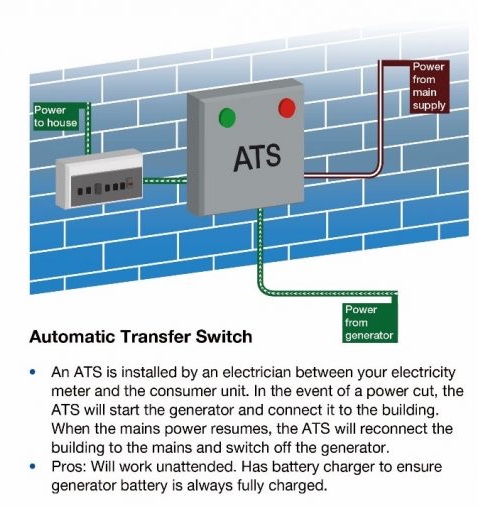
MTS - What does it do?
An MTS will do basically the same as ATS but as the name suggests, its a manual version. So what does that mean? In the event of a power cut you would need to start generator and also manually switch power supplies over on the switch gear. Also it would be up to you to monitor power supply to see when restored and switch back on again. The fact that you need to start and stop it manually as needed may better suit some applications of use.
Basic example of connection.
When installing these options you need need to get them installed by a trained electrician, you will nee to factor this cost in when purchasing the unit. We supply option for our back-up generator ranges and prices will vary. As you would have though, an ATS will cost more than an MTS option. MTS will go from about £200 upwards and ATS options from £600 although this may depend on the makes/models you are looking at.
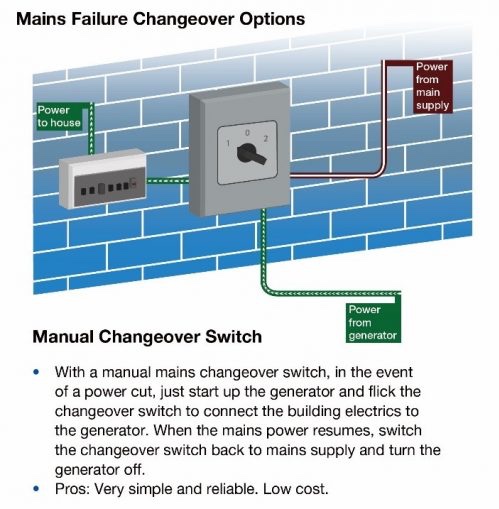
We strongly advise speaking to one of our team here at Lawn and Power to talk you through what would suit you and your application.
Tel sales on - 01656 742 739
Email - [email protected]
Posted in: Generator Advice
]]>When it comes to engines, there's no greater question we get asked, which is better, a diesel generator or a petrol generator?
It is a battle that extends to work sites, homes, businesses and farms across the UK. It's the battle of the generators.
At Lawn and Power Ltd, we know that diesel generators are some of the most cost-effective and fuel-efficient units you can buy. That said petrol generators have come of age and are taking on diesel generators at their own game.
Diesel Generator Pros
For decades, people only knew diesel as a dirty, smelly lorry or van fuel. But it's done a complete 180 to give petrol a run for its money. One of the biggest advantages of diesel engines is their fuel efficiency. This comes down to the diesel motor's higher compression. A like-for-like comparison of a diesel generator with a petrol generator will put the diesel ahead. With diesel, you also get a lower cost of ownership. That's why so many industries rely on diesel fuel to run their business, whether it's for generators, excavators, tractors or any other types of equipment used. Diesel engines, and therefore diesel generators, last longer, cost less to run and take longer to depreciate in value. Diesel engines last longer because don't have to work as hard as petrol engines to get the same power output. This means the engine parts are under less stress. Also, diesel fuel is self-lubricating which means the fuel delivery system should last longer than one on a petrol engine, perfect if the generator hasn't been used for a while. Diesel Generators are often more efficient and require less maintenance than their petrol counterparts. In fact, service intervals can be hundreds of hours apart. Another thing that gives the diesel engine the upper hand is the lack of an ignition system. It simply doesn't need one, which means one less thing to fail. What's more, they can operate at loads between 60% to 100% for prolonged periods, which is an advantage over their petrol counterparts. While you can find diesel generators powering smaller loads, such as domestic appliances for backup or DIY tasks, the advantages are best seen in more heavy industries.
Diesel Generator Cons
Diesel engines emit more noxious gases and CO2 per litre of fuel than petrol-powered engines. However, the upside is that because diesel engines use less fuel, they can also emit less CO2 over time. It all depends for how long you are using your generator. Cost is another factor. Traditionally, diesel has been more expensive than petrol – it is a few pence more per litre more in the UK and this can soon add up, although buying in bulk and using red diesel can offer you some great savings over the standard pump prices.
Even though diesel generators last longer and are less likely to fail, they may be more expensive to fix when they do.
Petrol Generator Pros
Besides the cost of petrol being lower than diesel, there are a few other pros for petrol. There is more choice of model for petrol generators. Like cars, this is because petrol generators have been around for longer. But that said, you'll find a growing selection of diesel generators for a whole range of applications and budgets these days; including home/business backup, trade/construction applications, backup for a solar set, power for events and much more.
While diesel generators are loved for their fuel efficiency, petrol generators are now being built with all kinds of economy modes and features to bridge the gap.
Petrol Generator Cons
Petrol is a much more volatile fuel than diesel. So if you're carrying lots of fuel for your generator, diesel is a safer option. Also, because of the way diesel engines work, they are much safer than petrol engines. There's no spark ignition, which means no risk of explosion and less maintenance than a petrol generator. At the same time, with petrol generators, today, a whole variety of safety features and checks are incorporated to ensure this isn't an issue anyway.
Another downfall of petrol generators is that they reach a higher temperature than their diesel counterparts. This leads to more wear and tear on the generator parts over time, meaning more frequent maintenance and repair, and ultimately, a short life span. Consequently, petrol generators are not usually run at high loads for extended periods. Another point to mention with fuel types would be how long the fuel will last before being used. The new E10 unleaded petrol is only recommended to be stored for 30 days, as it can go off or stale in short periods of time. This means you may have issues in starting your machine or it running correctly. The shelf life may be increased by adding fuel stabilizers when adding the fuel to the generator. Diesel is much longer-lasting vs petrol and much more suited to being used in backup or standby generators. It is less likely to go stale as it can last for up to 12 months with no issues.
So which is better for you?
It's a pretty close match ... we say that if you are looking to use the generator for heavy commercial use, then diesel is probably the way to go. But if you are already operating other equipment with petrol, then a petrol generator can do the job too. Power outputs will vary a lot but petrol will only cover up to about 10kW of power while diesel will go from 5kW upwards. Depending on the application you need a generator for will depend on what is best for you. Still not sure? Give one of our experts a call to go through your options now.
Posted in: Generator Advice
]]>Not sure what you need or the best machine to suit your needs. Don't panic, it's something lots of our customers face so we have put together a quick and simple guide to help you get started.
Here at Lawn and Power Ltd, it doesn’t matter if you are keen on DIY and looking to run power tools or you love camping holidays and want to power your digital devices while away, or even if you want some backup power the home or office in the event of a power cut, we have a solution for you!
What to look in a generator
Domestic or professional use: Smaller capacity generators are designed for home and leisure use, or for hobbyists. Bigger units are made with the pro user in mind, and are made for running machinery in workshops, or for commercial use.
Wattage: This is the most important consideration before you buy, the Wattage rating (kW) is the power the generator can produce when in operation. You will need to know the total wattage of all the electrical items you wish to power. If your generator is unable to provide enough power to the equipment you risk damaging the generator and your electrical items.
Equipment types: You need to know what types of equipment you want it to power. For instance, if you want it to power sensitive equipment such as PCs, laptops or TVs you may need an inverter generator to avoid damaging your equipment.
Fuel type: Generators can use a variety of different fuel types. Typical fuels include petrol, diesel, LPG or natural gas, and some will even offer a dual fuel option where it can run on either petrol or LPG.
Standby / backup or specialist generators: Recently standby or backup generators have become very popular, as they provide a buffer against power outages. It does not matter if you are looking to protect your home, office or a large factory, we are able to supply a suitable unit for your requirements. Some are even autonomous in their operation.
What is the total wattage required?
We get lots of calls that ask us - What size generator do I need? The answer will depend on factors such as what is it being used for. All model are rated to a certain wattage, you must work out the total wattage or power you need, it doesn't matter if you want to power just one laptop or a large factory, you will need to know this. The best way to do this is to make a list of what you want your generator to power, add up the wattage and add in a buffer of about 30% for any extra items you may want to plug in.
Example list (Wattage values are for reference only)
- Fridge - 600w
- Portable heater - 2000w
- Laptop - 300w
- 2 Lights - 30w each x 2 - 60w
- Wattage Total = 2860w
- Buffer at 30% - 888w
- Grand Total = 3848w
In the above example, we should be looking for a 3800w or 3.8kW generator to power the items on the list above.
Types of Generators
Inverter generators
Due to the fact that these engines are more complex, these will cost more than a comparable output traditional portable generator.
Inverter generators are also a lot quieter when compared to conventional portable ones, This is partly due to being encased and partly due to them being able to throttle up and down depending on the load required, they also tend to have better exhaust systems to help the lower sound.
They are fuel-efficient and produce fewer emissions.
Explore our range of inverter generators here (opens in new window)
Portable generators
Typically run on petrol and can be used on or off your property but must never be used in an enclosed space. Some models will offer an electric start. They run at 3000rpm and are at a fixed speed when in use and have higher noise levels than inverter generators. These are great for running jobs on sites and running power tools etc.
Standby or backup generators
These units will need to be installed so factor in some extra budget when looking at these, they can start and stop automatically in the event of a power cut. They also have self-diagnosis and will let you know when and what maintenance is needed. Some can even send a text or email alerts to keep you up to date.
This type of generator typically runs on red or white diesel but other fuel options like natural gas or and LPG are available. They come in sizes from 4kW upwards to very large units that can power tower blocks or large factories.
This type of generator operates at either 3000rpm or 1500rpm, with the 1500rpm units generally have longer lifespans and longer service intervals.
Explore our range of standby / backup generators here (opens in new window)
Still need more info? Then why not give us a call or email and we can talk you through your options.
Posted in: Generator Advice, Useful Information
]]>We thought we would show you some of the great features and how easy this machine is to use, we are sure by the end of this you will see how versatile it is and how it will save you time, fatigue, hassle, money & will make any post driving take a breeze.
So what can it do?
This machine is powered by the ultra-reliable GX35T 4-stroke Honda petrol engine, it has been designed to enable one man to knock any size stake, peg, or post into the ground, up to 100mm (4″) diameter. The high-impact hammer action of 1720 BPM will drive a post into the ground in a matter of seconds.
Let's take a quick look at it.
I
Benefits
- Physically less demanding than traditional methods
- Can be used all day without operator fatigue
- Portable – No pipes and generators needed
- Lightweight, only 15.3kg
Applications
- Any shape from 10mm – 100mm Ø
- Fencing – Timber and Angle Iron Posts
- Landscaping – Tree Stakes
- Nurseries – Tree and plant support
- Vineyards – Especially steep hillsides
- Farming – Sheep and cattle fencing
- Construction – Temporary fencing/shuttering/ground pinning
- Contractors – Tent Stakes/Ground Anchors/Signage
- Festival/Fair Organisers – Signage/Temporary fencing
Specifications
|
Blows per minute |
1720 |
|
Joules |
26 |
|
KW |
1.0 (1.3HP) at 7,000 rpm 4-stroke, overhead cam Trigger throttle with integrated stop button Spring isolated hand grips |
|
Vibration levels m/s2 |
9.24m/s sq (Data from 100mm diameter wooden post) |
|
Fuel consumption |
0.71 L/h at 7,000 rpm Meets strictest worldwide emission and noise requirements |
|
Starting system |
Recoil (pull start) |
|
Weight |
15.3kg |
|
Engine warranty |
1 Year genuine Honda warranty |
|
Post driver warranty |
3 year manufacturer warranty |
|
Noise level |
>100dB Hearing protection required |
Videos
Let's see it in action with some common types of posts, we can also offer custom posts attachments if needed. Just get in touch with us for a quote.
4", 3" & 2" stakes with the Multi Adapter
Vineyard Vineposts
Events and Festivals - Scaffold / Festoon Lighting / Marquee Pins
With this machine being so versatile it will be able to speed up so many post-driving tasks, so take a quick look at how easy it can be to change from one adaptor to another.
Changing the Multi Adapter sleeves; Easy Petrol Post Driver
So mow that you have seen what they can do for you and how easy it makes driving posts into the ground, let's take a look at the machines a little closer.
Designed to enable one man to knock any size stake, peg, or post into the ground, up to a 4” diameter. The high impact hammer action of 1720 BPM will drive a post into the ground in a matter of seconds, with the power pack being the ultra-reliable & compact Honda GX35T 4-Stroke Engine.
Easy Post Driver Honda Powered With 1 Adapter Supplied with a choice of adaptors, simply select the one you need when ordering.
Easy Post Driver Honda Powered With Multi Adapter Kit Supplied with three adaptors, select when ordering.
Do you want to check out the complete range? If so check them out HERE
Have you got any further questions? If so get in touch with one of our team HERE, or give us a call on 01656 742739
Posted in: Useful Information, Using Your Equipment
]]>We are pleased to announce that the Corba MX534SPH and MX51S80V lawnmowers have recently been awarded 'Best Buy' awards by T3.com, which is one of the UK's leading consumer lifestyle websites and the influential consumer expert, Which?
'The Cobra MX534SPH performs supremely well, cutting grass really effectively no matter how long or damp it is. It also leaves a really neat and tidy finish in its wake'
T3 Magazine June 2021
'This is a great Best Buy cordless mower with one of the most efficient grass collectors we’ve seen in a long time'
Which? May 2021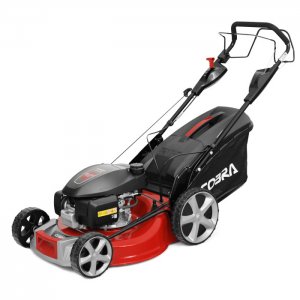
For more info on this lawnmower, follow this link HERE
The Cobra MX51S80V has also been selected as best buy by Which? This twin 40V battery 20" lawnmower is cordless, it will deliver 80V of cutting power with the 51cm cutting width, coming with a self-propelled drive system and 3-in-1 system. This machine is packed with features.
- 21" or 51cm cutting width
- 2-year warranty
- twin 40V power
- 55 min run-time
- Mulches
- Self-propelled
- only 29kg
- Thank 7 cutting heights 25-75mm
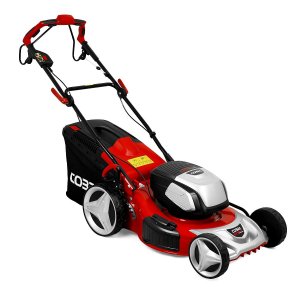
Want to see what Which had to say? look HERE
Posted in: Mower Advice, Useful Information
]]>By September this year 2021, the UK will be increasing the ethanol content in unleaded petrol from 5% to 10% as part of a move toward cutting greenhouse gas emissions in the country. For your car, this could mean decreased miles to the gallon due to ethanol's lower energy content, but what could it mean for petrol-powered garden tools? It could lead to an increase in customers with carburettor issues as storing petrol with higher ethanol content over extended periods can cause increased corrosion because ethanol tends to absorb moisture. Regardless of this ethanol increase, we always recommend that our customers drain the fuel from their garden equipment if it will not be used for two weeks or longer, as this could lead to stale fuel issues. It is good to note that the more expensive, premium quality super unleaded fuel will continue to contain 5% or less ethanol moving forwards, so customers will still have the choice of using petrol with lower ethanol content. We would advise using the more premium or super unleaded moving forward.
If you want advice on how to empty your carb when storing your machine to save you from getting any unwanted issues, please get in touch for advice for your machine.
Posted in: Useful Information, Using Your Equipment
]]>https://www.lawnandpower.co.uk/resources/pdfs/HYT140-HYT150-clutch-and-belt-guide.pdf
Posted in: Product Setup and Maintenance
]]>In this guide, you will find the following steps
- Check pipes for any damage before fitting
- Use thread sealer on pipes
- Connect the hose(s) to pump
- Priming of the pump
- Start engine on choke
- Engage full throttle to run
- Pump
- Demonstration Videos
Check the Pipes
Check all of the pipes and fittings for any cracks, or damage, especially if the system was shut down for long periods of time between uses. It is also worth checking things like nut & bolts, drain plugs are in place properly before you continue. It is also worth checking the manual to ensure all of the safety guards, belts and any pulleys are in the correctly in place.
Connect the Pipes
Firstly ensure you use a thread sealing tape and ensure the hose is connected to the couplers as airtight as possible. Use plenty of PTFE tape if needed.
Priming the Pump
Have a water supply at the ready, most people would use either a typical garden hose or water carrier to do this.
Important: To be done before starting the engine. On top of the pump housing, there will normally be a cap that needs to be removed (check instructions supplied with the pump to locate), you will need to top this up with water until its overflowing and starts pouring out of the pump, once this happens you need to replace cap nice and tight so no water can leak out when in use. You should check on this before trying to start the pump.
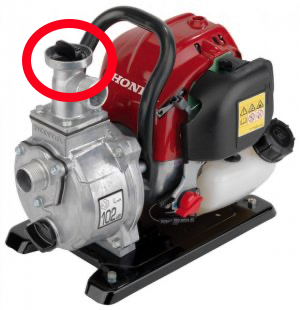
Starting the Engine
You will need to start the engine on choke and run it for a short while, you will then need to take off choke so the engine runs at full speed for the pump to work effectively and start to pump, again if you are unsure then please check instruction manual supplied with your unit.
Please note: Running the pump while dry can damage your pump and also void warranty too.
Start the Pump
Now you are ready to start the pump. Some pumps have a leaver to engage the pump, many just require the throttle to be on full. You may need to check those instructions once again.
Pump
Once the thottle is on full and the pump is engaged it may take a short while for water to start to flow.
Demonstration Videos
The following two videos will give you a guide of not only how to prime but also how long it can take for it to work correctly.
The following video will show you that the further you are pumping the longer it will take get going.
We hoped this has given you a brief understanding of how to prime your water pump before starting it up.
If you wanted to view the pumps that we offer please follow this link HERE to view our range.
Posted in: Useful Information, Using Your Equipment
]]>We put this together as we get asked this a lot, take a look at video's that answer the most asked questions about the Power Shed and outbuilding ranges.
Can you install a shed and how long will it take me?
How long does it take to install a Power Shed?
When you order the shed and it arrives you will need to unpack it and check that it is all there, please report any damage or missing components with 24hrs.
So first you will need to remove the transport block from the shed, let's take a look at how we do that,
Great now that is done we are ready to build you base, it's really easy so let's take a look and see what you have to do.
Building the shed base for the Power Shed
So, the base must be level so make sure to double-check this, or you can have some issues further down the line.
Great, it's level - go you! That didn't take long, did it?
What roof style did you go for? Pent or Apex?
Well, now it is time to get that shed put up!
To view how to install your brand new Power Shed Apex garden shed take a look at this below video, it has step by step instructions showing you how easy it is.
Install your brand new Apex Power Shed
To view how to install your brand new Power Shed Pent garden shed take a look at this below video, it has step by step instructions showing you how easy it is.
Install your brand new Pent Power Shed
Shed's up! Awesome you just need t felt the roof, let's get into it now.
Fitting the roofing felt
Well done you! that wasn't hard was it! Now it's time to get it loaded up and enjoy the extra storage you now have.
Look how flexible the Power Shed is.
Posted in: Product Setup and Maintenance, Useful Information, Using Your Equipment
]]>When shopping for a water pump there are various factors to consider. All water pumps are measured in discharge capacity L/min, vertical suction lift, and maximum head lift.
Discharge Capacity is the rate of speed that water flows from the source to the discharge point, measured in litres per minute. It provides the power to move water quickly. The higher the number the faster it will get the job done.
Vertical Suction Lift is the vertical distance from the water source to the pump. This is important for draining a basement or deep pond.
Maximum Head Lift is the total height from the source of the water to the destination or drainage point. This provides the power to move water over a distance.
Types of pumps and what they are used for;
Electric Submersible - These are great for many tasks such as emptying pools, ponds and flooded basement along with many other tasks, one of the benefits when using these is they sit in the floor to maximise the amount they remove before coming non-effective. These can be found for both clean and dirty type of fluid.
Petrol - These come in a range of sizes from 1” upwards and can handle Clean, dirty (trash) or chemicals through them, they offer much larger capacity when pumping so more can be done in a shorter time.
Diesel - These are typically used for commercial jobs or when it needs to run for longer periods of time, they can be used with regular or red diesel so reduces the running costs when compared to a similar spec petrol pump. These etc can be found as clean, chemical, dirty or trash options.
What can you pump?
Clean water - This is water with no particle within it so all pumps can handle this type of pumping.
Dirty water (Trash Pump) - These pumps will handle dirty water, this type of pump has an impeller that will break particles down within the suction feed, allowing it to pass through the pump. Maximum particle sizes are set by the manufacturer and usually displayed on the website, if in any doubt please get in touch before ordering.
Chemical pumps - As the name would indicate these can take a range of chemicals through them, they are commonly used for fertilisers, seawater, fuels etc. Many of these pumps also have the trash option too as it may be needed in certain applications
For a closer look at our range please follow this link HERE
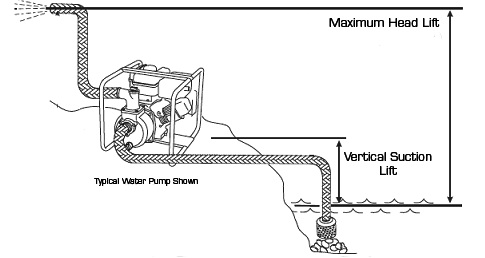
Posted in: Useful Information
]]>Types of Lawnmowers
Cylinder Mowers
Cylinder lawnmowers have cylindrical blades that rotate at the front of the mower. They cut against a fixed blade at the bottom of the machine. The cylinder will generally have multiple blades & typically three or more will give better results
Cylinder lawnmowers are best for very flat lawns that you want to keep short and well-manicured. They can be electric, petrol-powered and push mowers.
View our range of cylinder lawnmowers HERE
Rotary Mowers
Rotary lawnmowers have a blade that rotates horizontally underneath the mower,
Rotary lawn mowers are the most common type of mower and very versatile, they cope well with all types of grass and also much longer grass than a cylinder mower will do. They have a great range of features that can make you're mowing a better experience like electric start, roller facility, self-propelled, great range of sizes both in cutting width, powering options and grass collection.
These mowers can be powered via petrol, battery and electric options across many brands.
Take a look at some of our ranger HERE
Hover Mowers
Hover lawnmowers hover above the ground, making them easier to push and good mowing uneven surfaces. They are a good choice for unusual-shaped lawns as they are easy to move around and get in & out of hard to reach spots.
Hover lawnmowers are not a good choice for larger gardens. They are usually electric or petrol powered and have rotary blades.
Take a look at our hover mowers HERE
Lawnmower Power Options
Electric Lawnmowers
Electric lawnmowers are very cost-effective machines that start in price from under £80, these are used more in small to medium-sized gardens. One thing to remember is that you have a lead that plugs it into the power & trails behind the machine, can this lead get from the plug socket to the top of your garden?
See of our range HERE
Cordless Lawnmowers
Cordless battery-powered lawn mowers have come on great guns over the last few years, they offer a very easy to use a machine with low maintenance and easy to store. They are becoming the cleaner greener option for many people these days. No cables when being used just charge the battery and away you go, many of these batteries are cross-compatible with other garden tools also like hedge trimmers, strimmers & a whole range of other garden tools.
Pricing of these units can be seen as expensive but they are very convenient and when buying other machines you save money by not having to buy another battery.
Ready to take a look at the range, click HERE
Petrol Lawnmowers
Petrol-powered lawn mowers are the best choice for large gardens where a mains cable would be unsuitable. They are bit more expensive but much more powerful and faster at cutting. They are also easier to manoeuvre around large objects.
However, bear in mind that petrol lawnmowers will need servicing like car engines, and you will need to check and top-up the oil.
You should expect to pay £150 upwards for a petrol lawnmower, depending on your features yo are looking for.
Want to view the range, click HERE
Push Lawnmowers
These are generally smaller lawnmowers that you simply push along with your muscle power. They come as a cylinder, petrol mowers. They are best for small gardens and don’t use electricity or produce noise and emissions.
However, push lawnmowers are not suitable for larger or sloping gardens or people who have difficulty pushing.
You should expect to pay £40 to £100 for a push lawnmower.
Lawn Mowers & Garden Sizes
Think of your lawn as a tennis court. A full-size court would be a medium lawn, half the court or less would be a small lawn. Anything bigger is a large lawn.
You can use the below as a rough guide:
- Small lawn (up to 100 sq m): electric and cordless lawn mowers.
- Medium lawn (100 – 250 sq m): electric, cordless and petrol lawn mowers.
- Large lawn (250+ sq m): petrol lawn mowers.
Other Lawnmower Factors To Consider
Self-Propelled Lawnmowers
Some electric and petrol lawnmowers are self-propelled. This means that you don’t need to push them – simply steer them in the right direction!
It makes mowing much easier, especially with large lawns and heavy machines. Some models come with adjustable speeds, so you can set it to a comfortable walking pace.
Grass Box
It is generally advised to collect grass clippings rather than leaving them on the lawn. Most lawnmowers collect the clippings in a box at the back. This is better than mowers that leave you to rake them up afterwards!
If you have a medium or large lawn, look for a high-capacity grass box. This will cut down how often you need to stop mowing and empty the box.
Mulching Mowers
You can also get lawnmowers that chop up the grass clippings very finely and push them back into the lawn as mulch. These are sometimes called recycling mowers. The mulch adds nutrients back into the lawn.
The fine shredding helps the clippings break down quickly so they don’t smother the rest of the grass. Mulching mowers are expensive but a good choice if you don’t have anywhere to dispose of grass clippings.
Cutting Width
A lawn mower’s cutting width refers to how wide a stripe the lawnmower can cut. A larger cutting width will reduce how much time you spend mowing the lawn.
Here’s a handy guide using the lawn sizes from above.
- Small lawn: 300mm 12” cutting width.
- Medium lawn: 400mm 16” cutting width.
- Large lawn: 510mm 21” cutting width.
Cutting Height
The cutting height of mowers will vary in how many heights you have, most mowers will have between 5-7 and cut from about 20m-75mm. It is always worth comparing these when looking at your potential new lawnmower.
Rear Roller Mowers
If you are looking the having that traditional striped green lawn, you will see these on golf courses, football pitches & country houses alike that the UK is famous for, then you need to look at the roller mowers.
Robot Lawnmowers
A very fast-growing market as the prices are now coming down a lot, if you want a perfect lawn but don’t want to mow it yourself then these are becoming very popular. It is worth mentioning that there is a fair bit off set-up when they arrive but once done the mowers will take care of your lawn with little maintenance.
Contact us for more info or to help you choose your very own mower for your needs.
Posted in: Lawn care, Mower Advice, Useful Information
]]>The list is for guidance only and is not exhaustive.
All these points, and may others, are covered in detail in
the Ladder Association’s standard training course.
DO make sure you carry out a risk assessment
DO make sure a ladder is the correct piece of equipment for the job
DO make sure you are using the right classification of ladder
DO make sure you are wearing the correct footwear
DO make sure you are wearing a helmet
DO make sure the ladder is safe and in good condition
DO make sure it has two serviceable non-slip fleet
DO make sure the rungs are clean and secure
DO make sure it’s on a firm and level base
DO make sure the ladder is at the right height for the job
DO make sure it’s at the right angle for the job (70 – 75 degrees)
DO make sure you use a firm grip and three points of contact
DON’T work near electrical or overhead hazards
DON’T work in poor weather conditions
DON’T present a hazard to traffic or passers by
DON’T overload yourself with tools and materials
DON’T overreach to complete the task
DON’T stand on the top three rung
Posted in: Useful Information
]]>Posted in: Product Setup and Maintenance
]]>Posted in: Product Setup and Maintenance, Using Your Equipment
]]>- Air filter
- Spark Plug
- Oil
- Lawn Mower Blade
Posted in: Mower Advice, Product Setup and Maintenance
]]>- Air filter
- Spark Plug
- Oil
- Lawn Mower Blade
Posted in: Product Setup and Maintenance, Using Your Equipment
]]>Posted in: Product Setup and Maintenance
]]>Posted in: Product Setup and Maintenance
]]>Posted in: Product Setup and Maintenance
]]>